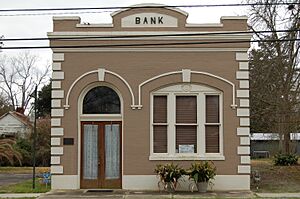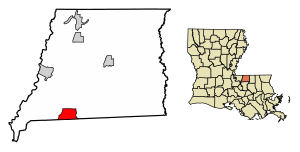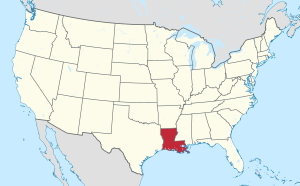Slaughter, Louisiana facts for kids
Quick facts for kids
Slaughter, Louisiana
|
|
|---|---|
|
Town
|
|
| Town of Slaughter | |

The historic Bank of Slaughter
|
|

Location of Slaughter in East Feliciana Parish, Louisiana.
|
|

Location of Louisiana in the United States
|
|
| Country | United States |
| State | Louisiana |
| Parish | East Feliciana |
| Area | |
| • Total | 5.48 sq mi (14.18 km2) |
| • Land | 5.47 sq mi (14.16 km2) |
| • Water | 0.01 sq mi (0.02 km2) |
| Elevation | 131 ft (40 m) |
| Population
(2020)
|
|
| • Total | 1,035 |
| • Density | 189.35/sq mi (73.11/km2) |
| Time zone | UTC-6 (CST) |
| • Summer (DST) | UTC-5 (CDT) |
| ZIP code |
70777
|
| Area code(s) | 225 |
| FIPS code | 22-70770 |
Slaughter is a small town located in East Feliciana Parish, Louisiana, in the United States. It's part of the larger Baton Rouge area. In 2020, about 1,035 people lived in Slaughter.
Contents
History of Slaughter
The town of Slaughter got its name from a train station. This station was part of the Illinois Central Railroad and served the farm of the Slaughter family.
A railroad called the Gloster Southern Railroad also served the town for many years, from 1987 to 2008. Slaughter officially became a town in 2002.
Geography of Slaughter
Slaughter is located in the southern part of East Feliciana Parish. It's right next to the city of Zachary, which is in East Baton Rouge Parish.
Louisiana Highway 19 is a main road that goes through Slaughter. If you go north on this highway, you'll reach Wilson in about 15 miles. Going south for about 20 miles will take you to Baton Rouge. The city of Clinton, which is the main town for East Feliciana Parish, is about 14 miles northeast of Slaughter.
The total area of Slaughter is about 5.48 square miles (14.2 square kilometers). Most of this area is land, with only a very small part being water.
People and Population in Slaughter
The number of people living in Slaughter has changed over the years. Here's a quick look at the population counts from different years:
| Historical population | |||
|---|---|---|---|
| Census | Pop. | %± | |
| 1900 | 259 | — | |
| 1910 | 287 | 10.8% | |
| 1920 | 215 | −25.1% | |
| 1930 | 327 | 52.1% | |
| 1940 | 306 | −6.4% | |
| 1950 | 290 | −5.2% | |
| 1960 | 403 | 39.0% | |
| 1970 | 580 | 43.9% | |
| 1980 | 729 | 25.7% | |
| 1990 | 827 | 13.4% | |
| 2000 | 1,011 | 22.2% | |
| 2010 | 997 | −1.4% | |
| 2020 | 1,035 | 3.8% | |
| U.S. Decennial Census | |||
Racial Makeup of Slaughter
The United States Census Bureau collects information about the people living in towns. This helps us understand the different groups that make up a community.
Here's a breakdown of the racial groups in Slaughter as of 2020:
| Race | Number | Percentage |
|---|---|---|
| White (non-Hispanic) | 878 | 84.83% |
| Black or African American (non-Hispanic) | 70 | 6.76% |
| Native American | 6 | 0.58% |
| Asian | 3 | 0.29% |
| Pacific Islander | 2 | 0.19% |
| Other/Mixed | 57 | 5.51% |
| Hispanic or Latino | 19 | 1.84% |
In 2020, there were 1,035 people living in Slaughter. These people lived in 435 households, and 298 of these were families. The average age of people in Slaughter was about 48 years old.
Back in 2000, there were 1,011 people. About 38% of the households had children under 18 living there. Most households (about 65%) were married couples living together.
Education in Slaughter
The East Feliciana Parish School Board is in charge of the schools in Slaughter. There are two schools located right in the town:
- Slaughter Elementary School
- Slaughter Community Charter School
See also
 In Spanish: Slaughter (Luisiana) para niños
In Spanish: Slaughter (Luisiana) para niños

